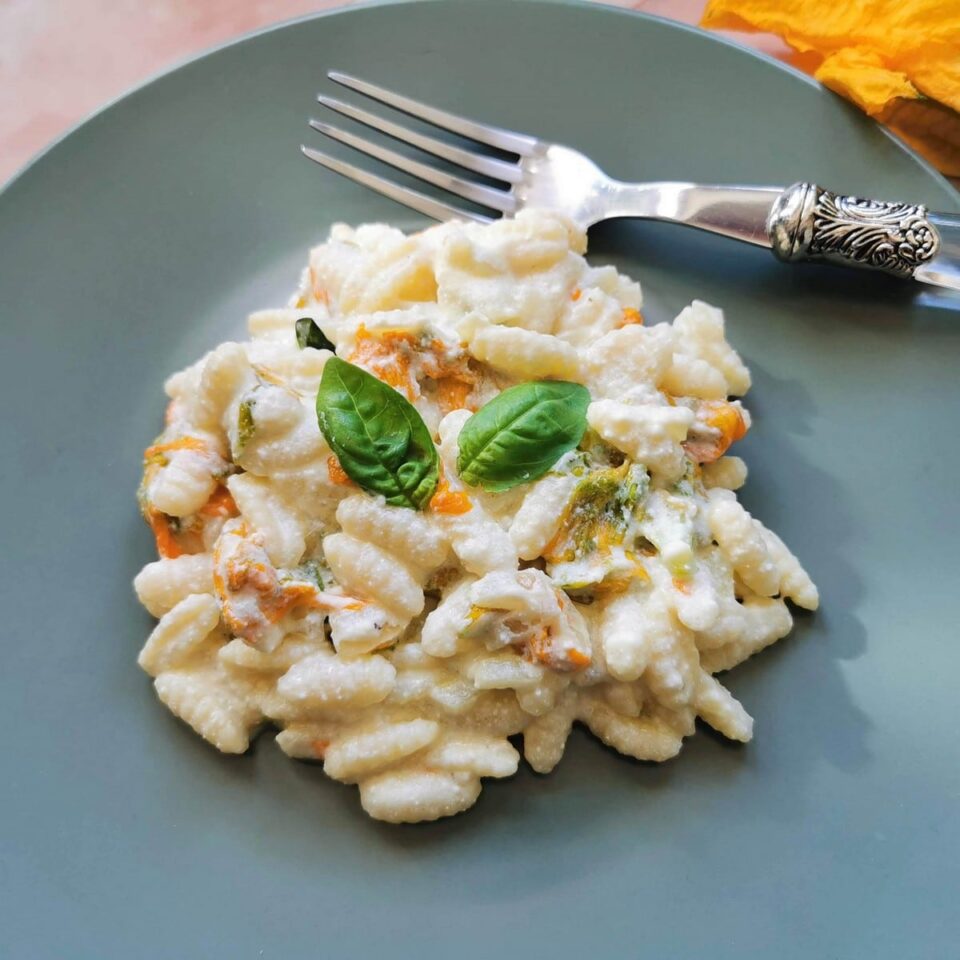These malloreddus with courgette flowers are made with a tasty and creamy ricotta and saffron sauce. The delicate flavor of courgette flowers makes the dish unique and delicious. Based on a traditional Sardinian recipe, this divine dish is also incredibly quick, preparing in less than 30 minutes.

History
Malloreddus, also called Sardinian gnocchi or ‘small Sardinian gnocchi’ are a typical pasta from Sardinia. Probably called gnocchi due to their shape, malloreddus resemble small potato gnocchi but are actually made with durum wheat semolina flour, water and salt.
When made at home, malloreddus sometimes have a pinch of ground saffron in the dough which gives the dough a slightly yellow color. To obtain the characteristic shape, Sardinians traditionally rolled the pieces of dough by hand onto a round cane basket. However, nowadays most people use a small wooden cutting board that resembles a dumpling board.


Saffron is a spice widely used in Sardinia because it has been cultivated there since the times of the Phoenicians. In fact, 60% of Italian saffron comes from the island. In addition to sometimes adding saffron to the malloreddus dough, Sardinians also use it in many recipes, including pasta.
Sheep’s cheese in Sardinia.
There are a lot of sheep in Sardinia, it seems there are 4 million! In fact, almost half of the sheep in Italy live in Sardinia! It goes without saying that this means that lamb and sheep’s milk products form an important part of the island’s cuisine.
In fact, many types of sheep’s milk cheese are made here, including much of Italy’s Pecorino Romano. Sheep’s ricotta is practically a staple in Sardinian cuisine and is often combined with saffron in sweet and savory recipes.
ingredients
Malloreddus (Sardinian gnocchi): This unique Sardinian pasta is excellent for capturing the creamy sauce. If you can’t find malloreddus, cavatelli are a good substitute due to their similar shape and texture.
Courgette flowers: These delicate flowers provide a subtle, slightly sweet flavor. If you can’t get courgette flowers, you can also use normal courgettes.
Ricotta: Provides the rich and creamy sauce. Fresh sheep’s ricotta is traditional, but cow’s milk can also be prepared.
Saffron: You can use either ½ sachet of saffron or ½ teaspoon of saffron pistils. Remember to soak the saffron threads in 3 tablespoons of warm water for at least 20 minutes before using them to allow the flavors to blend into the liquid.
Onion: Finely chopped to blend perfectly with the sauce.
Extra virgin olive oil: A quality olive oil that enriches the flavor of pasta sauce and vegetables.
Basil leaves: Fresh basil adds a pop of color and adds a burst of freshness.


Expert advice
Preparation of courgette flowers: Start by gently rinsing the courgette flowers under cold water to remove any traces of dirt. It is better to do this individually. Then, dry them carefully with absorbent paper. Next, open each flower to remove the stems and stamens, as these parts can be bitter. Then cut the flower crowns into strips.
Soaked saffron: To get the most flavor from saffron, measure ½ teaspoon of saffron threads and place them in a small bowl with 3 tablespoons of warm water. Allow this mixture to rest for at least 20 minutes before using. This soaking process allows the saffron to release its vibrant color and rich flavor, which will infuse beautifully into the ricotta sauce.
Step by step instructions
1) Bring a pot of water to the boil for the pasta. When it starts to boil, add salt and bring to the boil again. Then cook the malloreddus al dente according to the instructions on the package.
2) While the pasta is cooking, prepare the courgette flowers by washing them carefully and cutting the crowns of the courgette flowers into strips after removing the stem and stamens.


3) In a deep skillet or skillet, heat the olive oil over medium heat and sauté the onion until softened. Add the chopped courgette flowers and cook over low heat for a few minutes, stirring often. Turn off the heat and set aside.


4) In a bowl mix the ricotta, chopped basil, soaked saffron (including water), a drizzle of olive oil, a pinch of salt and black pepper.


5) Add half a cup of the pasta cooking water to obtain a creamy consistency.


6) Mix the saffron ricotta cream with the courgette flowers and onion in the pan.


7) Drain the cooked malloreddus, still keeping a little cooking water. Add the malloreddus to the pan with the courgette flower, ricotta and saffron mixture. Mix everything, adding a drop of the reserved pasta water if it is too thick.


8) Serve the creamy pasta, garnishing it with additional chopped basil and optionally grated pecorino romano.


Storage and leftovers
Leave any leftover malloreddus with courgette flowers to cool to room temperature. Next, transfer it to an airtight container and place it in the refrigerator. It will stay fresh for up to 3 days.
To reheat, place leftovers in a microwave-safe container. Cover it lightly and heat it on medium heat for about 2 minutes. Check the dough, stir and, if necessary, continue to heat in 30-60 second intervals until thoroughly heated.
Frequent questions
The saffron is ready when the water turns a deep yellow or orange color and the threads have softened. This indicates that the saffron has released its flavor and is ready to be used in your dish.
To chop courgette flowers quickly and effectively, stack several clean flowers on top of each other, roll them up, and then cut them into slices. This technique, known as chiffonade, is a quick way to cut into strips.
Squash flowers are most commonly available from late spring to early fall. They are typically found at farmers markets, but can sometimes be found in grocery stores with diverse, well-stocked vegetable departments.
Other saffron pasta recipes you might like:
If you prepare the recipe for malloreddus with courgette flowers, ricotta and saffron, I would be happy to know how they turned out and if you liked them. Please leave a comment here on the blog or at The Pasta Project Facebook page. Looking forward to hearing from you.
Bon appetite!
Pin for later:


If you are interested in learning how to make homemade pasta and different types of gnocchi, check out my shop page for some great online video courses taught by my friends in Rome! There’s nothing better than learning how to make pasta from Italians! More While you’re at it, why not order a copy of one of my pasta recipe books or check out some recommended pasta making tools?


